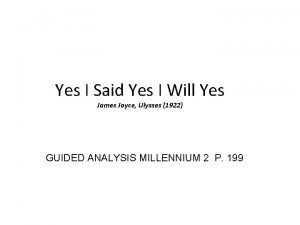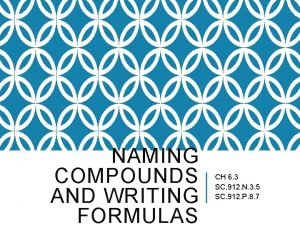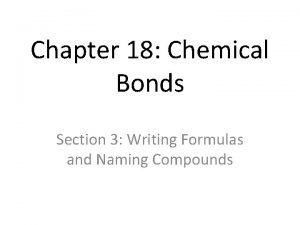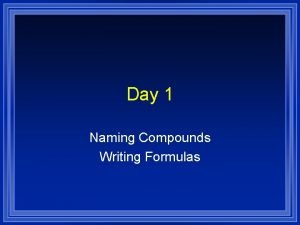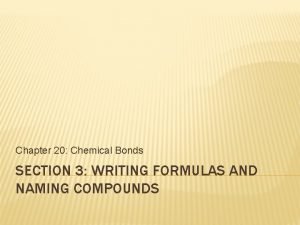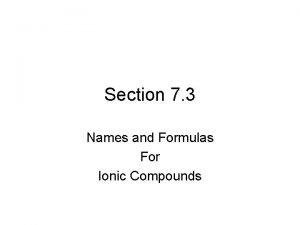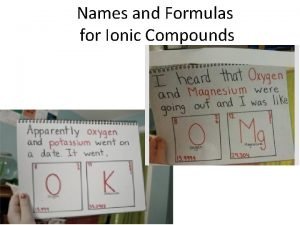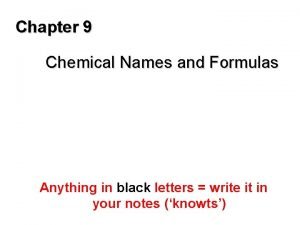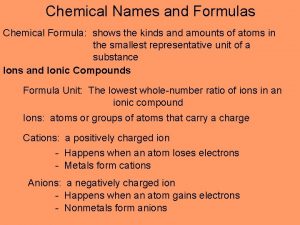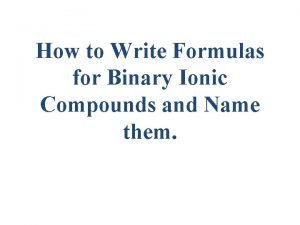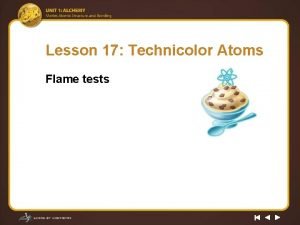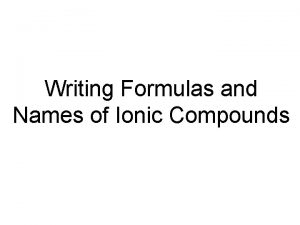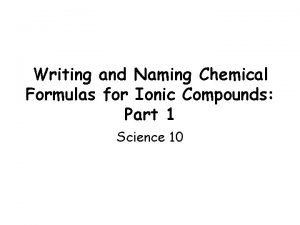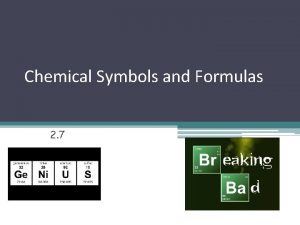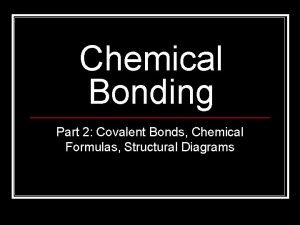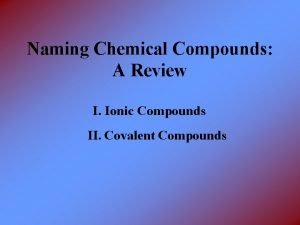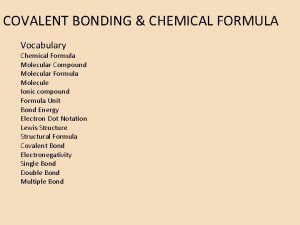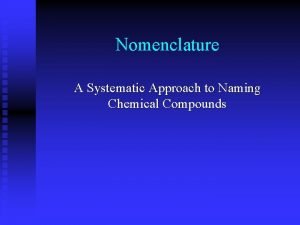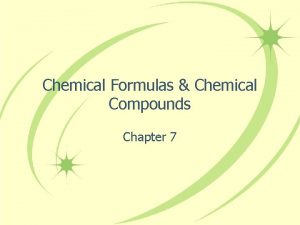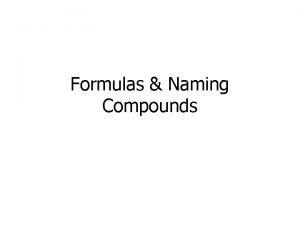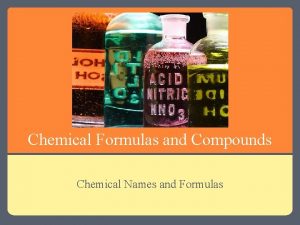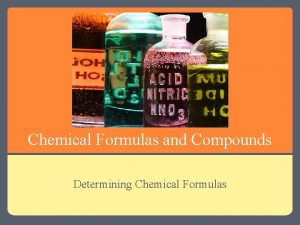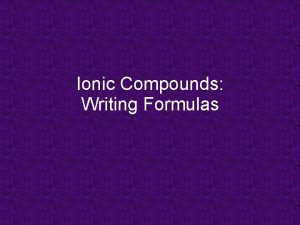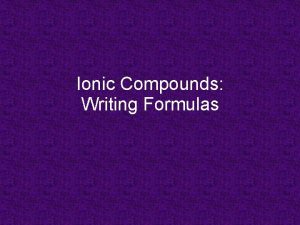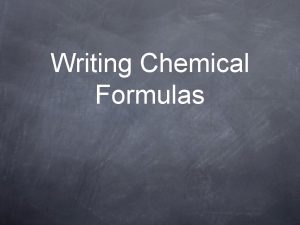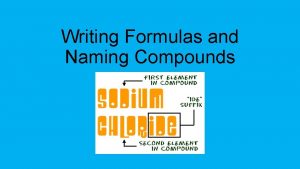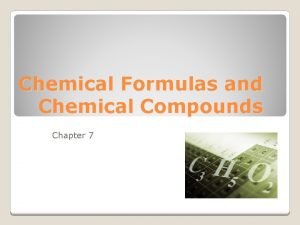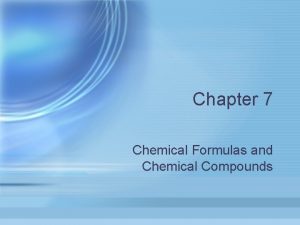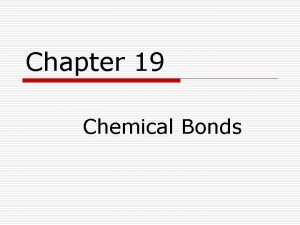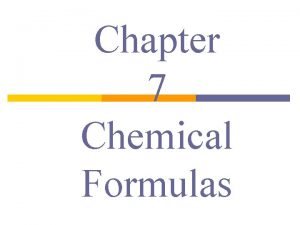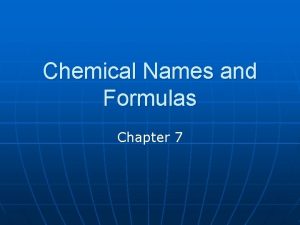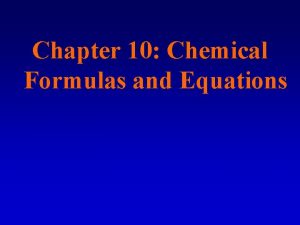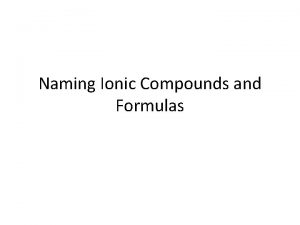Chapter 7 Chemical Formulas and Chemical Compounds Yes


































- Slides: 34

Chapter 7 “Chemical Formulas and Chemical Compounds” Yes, you will need a calculator for this chapter!

Using Formulas • How many oxygen atoms in the following? 3 atoms of oxygen Ca. CO 3 Al 2(SO 4)3 12 (3 x 4) atoms of oxygen • How many ions in the following? Ca. Cl 2 3 total ions (1 Ca 2+ ion and 2 Cl 1 - ions) 2 total ions (1 Na 1+ ion and 1 OH 1 - ion) Na. OH Al 2(SO 4)3 5 total ions (2 Al 3+ + 3 SO 42 - ions)

Review Problems § How many molecules of CO 2 are in 4. 56 2. 75 x 1024 molecules moles of CO 2? § How many moles of water is 5. 87 x 1022 0. 0975 mol (or 9. 75 x 10 -2) molecules? § How many atoms of carbon are in 1. 23 moles of C 6 H 12 O 6? 4. 44 x 1024 atoms C § How many moles is 7. 78 x 1024 formula units of Mg. Cl 2? 12. 9 moles

More Practice § How many grams is 2. 34 moles of carbon? 28. 1 grams C § How many moles of magnesium is 24. 31 g of Mg? 1. 000 mol Mg § How many atoms of lithium is 1. 00 g of Li? 8. 68 x 1022 atoms Li § How many grams is 3. 45 x 1022 atoms of U? 13. 6 grams U

What about compounds? § In 1 mole of H 2 O molecules there are two moles of H atoms and 1 mole of O atoms (think of a compound as a molar ratio) § To find the mass of one mole of a compound – determine the number of moles of the elements present – Multiply the number times their mass (from the periodic table) – add them up for the total mass

Calculating Formula Mass Calculate the formula mass of magnesium carbonate, Mg. CO 3. 24. 31 g 12. 01 g 16. 00 g 24. 31 g/mol + 12. 01 g/mol + 3 x (16. 00 g/mol) = 84. 32 g/mol Thus, 84. 32 grams/mol is the formula mass for Mg. CO 3.

Molar Mass § Molar mass is the generic term for the mass of one mole of any substance (expressed in grams/mol) § The same as: 1) Gram Molecular Mass (for molecules) 2) Gram Formula Mass (ionic compounds) 3) Gram Atomic Mass (for elements) – molar mass is just a much broader term than these other specific masses

Examples § Calculate the molar mass of the following: Na 2 S N 2 O 4 C Ca(NO 3)2 C 6 H 12 O 6 (NH 4)3 PO 4 = 78. 05 g/mol = 92. 02 g/mol = 12. 01 g/mol = 164. 1 g/mol = 180. 156 g/mol = 149. 096 g/mol

Since Molar Mass is… § The number of grams in 1 mole of atoms, ions, or molecules, § We can make conversion factors from these. - To change between grams of a compound and moles of a compound.

For example § How many moles are in 5. 69 g of Na. OH?

For example • How many moles are in 5. 69 g of Na. OH?

For example • How many moles are in 5. 69 g of Na. OH? • We need to change 5. 69 grams Na. OH to moles

For example • How many moles are in 5. 69 g of Na. OH? We need to change 5. 69 grams Na. OH to moles l 1 mole Na = 22. 99 g 1 mol O = 16. 00 g 1 mole of H = 1. 008 g l

For example • How many moles are in 5. 69 g of Na. OH? We need to change 5. 69 grams Na. OH to moles l 1 mole Na = 22. 99 g 1 mol O = 16. 00 g 1 mole of H = 1. 008 g l 1 mole Na. OH = 39. 998 g l

For example • How many moles are in 5. 69 g of Na. OH? We need to change 5. 69 grams Na. OH to moles l 1 mole Na = 22. 99 g 1 mol O = 16. 00 g 1 mole of H = 1. 008 g l 1 mole Na. OH = 39. 998 g l

For example • How many moles are in 5. 69 g of Na. OH? We need to change 5. 69 grams Na. OH to moles l 1 mole Na = 22. 99 g 1 mol O = 16. 00 g 1 mole of H = 1. 008 g l 1 mole Na. OH = 39. 998 g l

Calculating Percent Composition of a Compound § Like all percent problems: part whole x 100 % = percent • Next, divide by the total mass of the compound; then x 100 • Find the mass of each of the components (the elements),

Example § Calculate the percent composition of a compound that is made of 29. 0 grams of Ag with 4. 30 grams of S. 29. 0 g Ag X 100 = 87. 09 % Ag 33. 3 g total Total = 100 % 4. 30 g S X 100 = 12. 91 % S 33. 3 g total

Getting it from the formula § If we know the formula, assume you have 1 mole, § then you know the mass of the elements and the whole compound (these values come from the periodic table!).

Examples § Calculate the percent composition of C 2 H 4. 85. 63% C, 14. 37 % H § How about aluminum carbonate? 23. 06%Al, 15. 40% C, and 61. 54 % O

Formulas Empirical formula: the lowest whole number ratio of atoms in a compound. Molecular formula: the true number of atoms of each element in the formula of a compound. • Example: molecular formula for benzene is C 6 H 6 (note that everything is divisible by 6) • Therefore, the empirical formula = CH (the lowest whole number ratio)

Formulas (continued) Formulas for ionic compounds are ALWAYS empirical (the lowest whole number ratio = cannot be reduced). Examples: Na. Cl Mg. Cl 2 Al 2(SO 4)3 K 2 CO 3

Formulas (continued) Formulas for molecular compounds might be empirical (lowest whole number ratio). Molecular: (Correct formula) Empirical: (Lowest whole number ratio) H 2 O C 6 H 12 O 6 C 12 H 22 O 11 H 2 O CH 2 O C 12 H 22 O 11

Calculating Empirical § Just find the lowest whole number ratio = CH 2 O C 6 H 12 O 6 CH 4 N = this is already the lowest ratio. § A formula is not just the ratio of atoms, it is also the ratio of moles. § In 1 mole of CO 2 there is 1 mole of carbon and 2 moles of oxygen. § In one molecule of CO 2 there is 1 atom of C and 2 atoms of O.

Calculating Empirical § We can get a ratio from the percent composition. 1) Assume you have a 100 g sample - the percentage becomes grams (75. 10% = 75. 10 grams) 2) Convert grams to moles. 3) Find lowest whole number ratio by dividing each number of moles by the smallest value.

Example § Calculate the empirical formula of a compound composed of 38. 67 % C, 16. 22 % H, and 45. 11 %N. § Assume 100 g sample, so § 38. 67 g C x 1 mol C = 3. 2198 mol C 12. 01 g C § 16. 22 g H x 1 mol H = 16. 0913 mol H 1. 008 g H § 45. 11 g N x 1 mol N = 3. 2198 mol N 14. 01 g N Now divide each value by the smallest value

Example § The ratio is 3. 2198 mol N = 1 mol N 3. 2198 mol N § The ratio is 3. 2198 mol C = 1 mol C 3. 2198 mol N § The ratio is 16. 0913 mol H = 5 mol H 3. 2198 mol N = C 1 H 5 N 1 which is = CH 5 N

Practice § A compound is 43. 64 % P and 56. 36 % O. What is the empirical formula? § P 2 O 5 § Caffeine is 49. 48% C, 5. 15% H, 28. 87% N and 16. 49% O. What is its empirical formula? § C 4 H 5 N 2 O

Empirical to Molecular § Since the empirical formula is the lowest ratio, the actual molecule would weigh more. § By a whole number multiple. § Divide the actual molar mass by the empirical formula mass – you get a whole number to increase each subscript in the empirical formula § Caffeine has a molar mass of 194 g. what is its molecular formula? = C 8 H 10 N 4 O 2

Hydrates • Hydrate: a compound that has a specific number of water molecules bound to its atoms • You can determine the formula of a hydrate by heating it until the water is gone, and analyzing the data

Ba. Cl 2 ? H 2 O • Mass of the compound before heating (hydrate): 5. 00 g • Mass after heating (anhydrous): 4. 26 g • Find the mass of the water lost by subtracting 5. 00 g – 4. 26 g = 0. 74 g H 2 O • The mass of just the Ba. Cl 2 is 4. 26 g

Continued • Convert the mass of Ba. Cl 2 and the mass of H 2 O to mol • 4. 26 g Ba. Cl 2 1 mol Ba. Cl 2 = 0. 02046 mol 208. 2 g Ba. Cl 2 • 0. 74 g H 2 O 1 mol H 2 O = 0. 04107 mol 18. 016 g H 2 O • Divide by the smallest molar value

Continued • 0. 02046 mol Ba. Cl 2 = 1 0. 02046 mol Ba. Cl 2 • 0. 04107 mol H 2 O = 2 0. 02046 mol Ba. Cl 2 • Formula of the hydrate: Ba. Cl 2 2 H 2 O

Another Practice • Fe. PO 4 ? H 2 O • Mass before heating: 7. 61 g • Mass after heating: 5. 15 g • Mass of water: 2. 46 g • Formula of the hydrate: Fe. PO 4 4 H 2 O
 Yes i said it
Yes i said it I am trading my sorrows
I am trading my sorrows Piccolo yes yes yes
Piccolo yes yes yes Empirical formula and molecular formula pogil
Empirical formula and molecular formula pogil 7-3 practice problems chemistry answers
7-3 practice problems chemistry answers Naming chemical compounds
Naming chemical compounds Trading
Trading Tribromine octoxide formula
Tribromine octoxide formula Venn diagram ionic and covalent bonds
Venn diagram ionic and covalent bonds Naming and writing formulas for molecular compounds
Naming and writing formulas for molecular compounds Prefixes for hydrates
Prefixes for hydrates Monatomic formula
Monatomic formula Tetraiodine nonaoxide formula
Tetraiodine nonaoxide formula Section 3 writing formulas and naming compounds
Section 3 writing formulas and naming compounds Section 3 names and formulas for ionic compounds
Section 3 names and formulas for ionic compounds Section 3 names and formulas for ionic compounds
Section 3 names and formulas for ionic compounds Chemical names and formulas worksheet chapter 9
Chemical names and formulas worksheet chapter 9 Chemistry chapter 9 chemical names and formulas
Chemistry chapter 9 chemical names and formulas A chemical formula shows the
A chemical formula shows the Formula of binary compound
Formula of binary compound Ternary compound definition
Ternary compound definition Lesson 17 technicolor atoms flame test worksheet answers
Lesson 17 technicolor atoms flame test worksheet answers Nhmno4
Nhmno4 Ionic compounds properties
Ionic compounds properties 7 ionic and metallic bonding practice problems
7 ionic and metallic bonding practice problems In an ionic compound the chemical formula represents
In an ionic compound the chemical formula represents Counting atoms worksheet
Counting atoms worksheet Mol formul
Mol formul Covalent covalent bond
Covalent covalent bond Naming ionic compounds criss cross method
Naming ionic compounds criss cross method How to name ionic compounds
How to name ionic compounds Ionic bonding problems
Ionic bonding problems Covalent compound chemical formula
Covalent compound chemical formula What is the difference between molecule and compound
What is the difference between molecule and compound Hcn binary or ternary
Hcn binary or ternary
